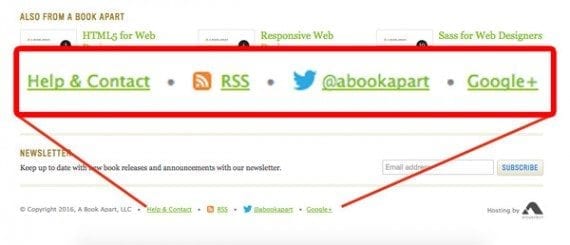
Suples Training Systems was one of 99 retail websites reviewed in an effort to learn more about what sort of content belongs in a footer.
Stuffed full of links, contact information, legal notices, email subscription forms, and social media icons, the footer section of many ecommerce web pages might seem like pure miscellany. Nonetheless, I recently studied nearly a hundred of these footers and gained some interesting insights into what an online retailer should include in the bottom section of its website.
On June 27 and 28, 2016, I cataloged the footer sections on 99 retail websites. I counted the number of links in the footer, the types of legal notices, and even the marketing options.
This survey of retail footers featured websites like Amazon, Zulily, Beardbrand, and Wayfair. There were large retail sites, including Walmart, Target, and Macy’s. There were specialty stores like Suples Training Systems (fitness equipment), littleBits (electronic building blocks), Things from Another World (comics and toys), and Balsam Hill (Christmas trees). Several subscription services — Dollar Shave Club, BarkBox, and Blue Apron, as examples — were among those inspected, as were fashion sites, hardware stores, and sites selling foodstuffs.
Retail Footers Are Content Hubs
On average, the sites that I surveyed had 35 links in their footer sections.
A Book Apart had the fewest links. Not counting the subscribe button on its email newsletter form or the link to the site’s web host, there were just four.
Amazon, with 79 links, had the most.
Most of the sites that I reviewed used page footers as content hubs. These sections of the page were home to important links for shoppers who wanted to dig deeper into the store’s policies, procedures, or content.
Some 92 percent of the sites reviewed included a link to the store’s privacy policy in the footer, and 89 percent had a link labeled “terms of use,” “conditions of use,” or similar.
A link to an about page was included on 79 percent of the sites, and 78 percent of the sites had a link for contacting the store. On 67 percent of the 99 sites, one could find a specific customer service link or links. Shipping policy and return policy links showed up on 52 percent and 57 percent of the sites examined, respectively.
Copyright Protection Included Often
Copyright protection notification was the most common feature, with 98 percent of the sites reviewed including it.

The Barnes & Noble website, like the vast majority of sites considered, includes a copyright notification in its footer section.
In the United States, original works are copyright protected without registration and without notification. For a website, this means original text, artwork, images, and rich media are automatically protected. Thus, most of the retail sites surveyed have copyright protection with or without the notification in their footers.
Nonetheless, the vast majority of retailers reviewed chose to include a copyright notification. This may simply mean website designers are in the habit of including a copyright symbol, or it may be an indication of just how important copyright protection is.
If an online store spends the money to photograph all of the products it sells, those photos are original works and are copyright protected. A competitor cannot use those pictures — even if that competitor sells the same product. The notification in the footer may serve as a deterrent.

Outfitter and retailer Cabela’s is another example of a website that includes a copyright notice in its site footer.
While copyright protection is automatic, a retailer does need to officially register a copyright if that retailer intends to file a lawsuit. The U.S. government has a website, Copyright.gov, that answers many questions about copyright law.
Marketing Content Settles to the Bottom
The footer is also where shoppers can connect with stores they like on social media or interact with retailers’ other marketing efforts.
Some 86 percent of the site footers examined included links to social media sites like Facebook, Twitter, Instagram, and Pinterest.

The Bass Pro Shops website, like most of the 99 websites examined for this article, included an array of social media links in its footer.
Similarly, 73 percent of the sites had an email newsletter subscription form in their footers. Several sites also invited shoppers to subscribe to text notifications or connect on messaging services like WhatsApp.

Suitsupply includes an email subscription form, social media icons, and a WhatsApp number in its site footer.
A bit less than half (42 percent) of the site footers included a link to some form of content marketing. In some cases this was a simple link to a blog. On other sites there might be several links devoted to content.
Job Openings in Footer
Eighty-seven percent of the site footers considered for this article had a job or careers link. With so many sites hiring in their footers, don’t be surprised if perspective employees look there first.
Several Surprises, Too
Some of the footer elements one might have expected to find were not as common. For example, a site map link might seem like it would be popular, but just 43 percent of the site footers included one. That’s just 1 percentage point (and, really, one site) more than those footers including content marketing links.
Trust badges indicating a site is secure or a good corporate citizen appeared in 31 percent of the footers review for this article.

Trust badges appeared on 31 percent of the sites surveyed. The Google Trusted Store badge, like the one in the Wayfair footer, was one of the most common trust badges seen.
Showing payment icons like a Visa symbol or a PayPal badge is apparently unnecessary. Only 5 percent of the sites had payment icons in their footers. When the icons did appear, PayPal was most often used.
What Belongs in Your Footer?
Reviewing what 99 pseudo-randomly selected retailers have chosen to include in their site footers is not a scientific study. So the percentages shown in this article cannot be applied to the ecommerce or retail world generally.
While it is a fact that 42 percent of the 99 sites examined for this article included a phone number in their footers, it would not be accurate to say 42 percent of all retail sites have phone numbers displayed in their footers. That would not be correct and it would not be good use of this data.
This information, however, can help retailers decide what to include in a site footer. If these 99 sites are indications, be sure your site’s footer has links to policies and procedures, a copyright notification, links to social media sites, a newsletter subscription form, contact information, and content marketing links.







